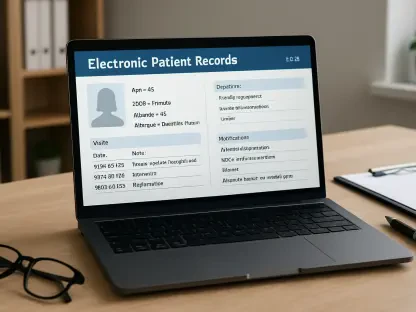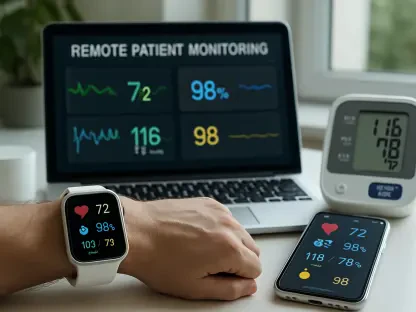In an era where healthcare providers are increasingly disillusioned with technology, voice-driven AI emerges as a beacon of hope, promising to mend the fractured relationship between clinicians and digital tools, and addressing the frustration among doctors and nurses who grapple with systems like electronic medical records (EMRs). These systems often prioritize data over patient interaction, adding hours of administrative work to already demanding schedules. This growing mistrust isn’t just a minor inconvenience; it’s a critical barrier to the effective integration of tech solutions in medicine, contributing to widespread burnout and dissatisfaction. Nearly half of physicians report feeling exhausted, a statistic that underscores the urgency of finding a better way. Voice-driven AI offers a novel approach by tapping into the most instinctive form of human communication—speech—allowing healthcare professionals to focus on what matters most: their patients. This article explores how this technology is addressing deep-seated trust issues, alleviating burdens, and reshaping the landscape of healthcare delivery.
Bridging the Gap with Natural Communication
Easing the Administrative Load
Voice-driven AI stands out as a transformative force in healthcare by directly tackling one of the most significant sources of clinician frustration: the crushing administrative workload. Traditional EMR systems often demand extensive manual data entry, forcing doctors to spend over five hours on documentation for every eight hours of patient care, with additional time often spilling into personal hours. This imbalance not only drains energy but also detracts from the core mission of medicine—building meaningful patient relationships. By contrast, voice AI enables clinicians to dictate notes and update records through natural speech, mimicking the ease of conversing with a colleague. This intuitive interface slashes the time spent on keyboards, freeing up mental space for clinical decision-making. The result is a noticeable reduction in the cognitive strain that documentation imposes, allowing healthcare providers to redirect their focus to the individuals in their care rather than the screens in front of them.
The impact of this shift is already evident in real-world applications, demonstrating how voice AI can restore balance to clinicians’ daily routines. At The Permanente Medical Group, for instance, the deployment of ambient AI scribes to thousands of physicians led to remarkable outcomes, with over 3,400 providers adopting the technology across hundreds of thousands of patient encounters in just weeks. Physicians reported saving about an hour of keyboard time each day, a gain that translated into the capacity to see additional patients when needed. This boost in efficiency highlights a critical advantage of voice-driven solutions: they align technology with the practical needs of healthcare workers. Beyond mere time savings, such innovations signal a departure from rigid, burdensome systems toward tools that adapt to human workflows, fostering a sense of empowerment among providers who have long felt constrained by digital demands.
Preserving the Human Touch in Medicine
One of the most compelling benefits of voice-driven AI lies in its ability to preserve the human connection that defines quality healthcare. When clinicians are tethered to EMR interfaces, they often face an impossible choice between maintaining eye contact with patients and ensuring accurate record-keeping—a dilemma that can erode trust and rapport. Voice AI elegantly resolves this conflict by capturing natural conversations during visits and automatically converting them into structured documentation. This seamless process allows doctors to remain fully present, engaging with patients without the distraction of typing or navigating complex menus. Patients, in turn, perceive their providers as more attentive, which strengthens the therapeutic bond essential to effective care. This technology thus serves as a bridge, ensuring that digital tools enhance rather than hinder the personal interactions at the heart of medicine.
Further reinforcing this human-centric approach, voice AI addresses a deeper emotional need within healthcare settings by reducing the sense of alienation that technology often creates. Studies have shown that patients feel more valued when their doctors aren’t preoccupied with screens, as the use of voice tools minimizes visible distractions during consultations. Meanwhile, clinicians report a renewed sense of purpose when they can prioritize listening over logging data. This mutual benefit creates a positive feedback loop, where both parties experience improved satisfaction from their encounters. Additionally, the global voice technology market in healthcare reflects this growing recognition, with projections estimating growth from $4.23 billion to over $21 billion by 2032. Such figures underscore an industry-wide shift toward solutions that honor the interpersonal dynamics of care, positioning voice AI as a pivotal tool in restoring a patient-first ethos to an increasingly digitized field.
Overcoming Obstacles to Widespread Adoption
Navigating Technical and Security Challenges
While voice-driven AI holds immense potential to transform healthcare, its path to widespread adoption is not without hurdles, particularly in the realm of technical performance and data security. Accuracy remains a critical concern, as systems must contend with diverse accents, specialized medical terminology, and the complexities of multi-speaker environments. In controlled settings, word error rates can be impressively low, but in real-world scenarios, they sometimes spike significantly, risking errors in documentation. However, recent strides in natural language processing and large language models have pushed accuracy rates above 98% for clinical tasks, with systems continuously improving through adaptive learning. Integration with existing EMR platforms also poses challenges, requiring careful design to ensure seamless functionality. Despite these issues, ongoing advancements suggest that technical barriers are becoming increasingly surmountable as the technology matures.
Equally pressing are the privacy and security concerns that accompany voice AI, given the sensitive nature of healthcare data. Clinicians and patients alike harbor valid apprehensions about the potential misuse or breach of recorded conversations. Fortunately, robust safeguards within the industry are addressing these fears head-on. Solutions such as HIPAA-compliant encryption, secure cloud storage, and strict access controls ensure that voice AI systems adhere to stringent data protection standards. Many platforms further mitigate risks by avoiding local storage of audio, instead transmitting encrypted data to fortified servers. Compliance with international regulations like GDPR adds another layer of reassurance, demonstrating a commitment to confidentiality. By embedding these protective measures, voice AI developers are working to build confidence among stakeholders, proving that the technology can be both innovative and trustworthy in handling personal health information.
Unlocking Economic and Operational Gains
The economic rationale for adopting voice-driven AI in healthcare is compelling, as it directly addresses the staggering costs associated with administrative inefficiencies. In the U.S., up to 30% of total healthcare expenditure is tied to administrative tasks, with a significant portion considered avoidable. Voice AI offers a tangible solution, with projections estimating annual savings of around $12 billion for providers by 2027 through reduced documentation time. This financial relief is not merely theoretical; it aligns with broader goals of sustainability in healthcare systems under constant budget strain. By streamlining workflows, the technology enables institutions to reallocate resources toward patient care initiatives, creating a synergy between fiscal responsibility and clinical priorities. Such cost-effectiveness makes a strong case for investment, positioning voice AI as a strategic asset in an industry seeking to balance quality with affordability.
Beyond direct savings, the operational benefits of voice AI further amplify its value, particularly in enhancing productivity among clinicians. Research published in prominent medical journals reveals that physicians using AI scribes have increased their visit volume by as much as 10.8% after an initial adjustment period, alongside a substantial reduction in documentation time—up to 28.1% for high-intensity users. This uptick in capacity means that healthcare facilities can serve more patients without compromising care standards, addressing access issues that plague many communities. Moreover, the ripple effect of these gains extends to staff morale, as reduced clerical burdens correlate with lower burnout rates. The alignment of economic incentives with improved outcomes for both providers and patients underscores why voice-driven solutions are gaining traction, offering a pragmatic pathway to optimize resources while maintaining a focus on delivering compassionate, effective care.
Paving the Way for a Trust-Based Future
Catalyzing Acceptance of Broader AI Innovations
Voice-driven AI serves as more than a standalone tool; it acts as a catalyst for broader acceptance of artificial intelligence within healthcare by demonstrating tangible, trust-building benefits. When clinicians experience firsthand how voice tools alleviate administrative pressures and enhance patient interactions, their skepticism toward other AI applications often diminishes. This shift in perception is crucial, as initial positive encounters with accessible, intuitive technologies can pave the way for embracing more complex systems, such as predictive analytics or diagnostic aids. The success of voice AI thus creates a domino effect, where each favorable outcome builds credibility for digital innovation as a whole. This gradual acclimation is essential in an industry where resistance to change has historically slowed progress, positioning voice-driven solutions as a gateway to a more tech-friendly medical culture.
The broader implications of this trend extend to systemic transformation, as voice AI helps redefine the role of technology from a perceived burden to a trusted ally. Early adopters who report higher job satisfaction and reduced stress become advocates within their networks, amplifying the technology’s reach through peer influence. This grassroots momentum is vital for overcoming entrenched doubts about AI’s place in medicine, particularly concerns over autonomy and accountability. Furthermore, as healthcare organizations witness improved patient engagement metrics—such as higher satisfaction scores during voice-enabled visits—they gain confidence in scaling AI initiatives. The resulting trust dividend fosters an environment where innovation is met with curiosity rather than caution, laying a foundation for future advancements that prioritize both efficiency and empathy in equal measure.
Reflecting on a Human-Centered Legacy
Looking back, the integration of voice-driven AI marked a turning point in healthcare, as it tackled the pervasive trust crisis with a solution rooted in human communication. Its ability to lighten administrative loads through intuitive speech interfaces reshaped clinicians’ daily experiences, while transparent processes reassured providers of their control over critical decisions. Patients, too, felt the impact, as doctors appeared more attentive without the barrier of constant screen interaction. Even challenges like technical accuracy and privacy were met with robust advancements and strict compliance measures, ensuring the technology adapted to real-world demands. Economically, the savings and productivity gains proved transformative, aligning financial and clinical goals. Ultimately, the legacy of voice AI lay in its role as a bridge, restoring faith in technology by placing human connection at the forefront of digital progress, and setting a precedent for future innovations to follow.









